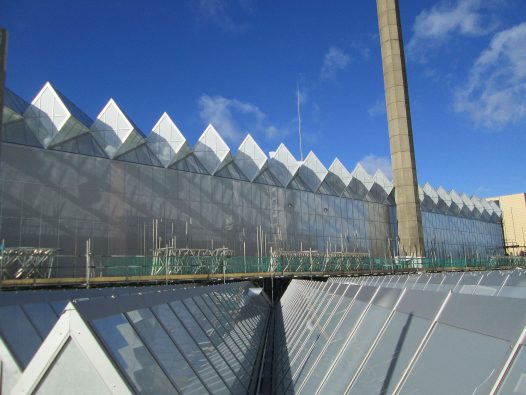Curtain walls are the signature element of modern architecture design. You can see them in high-rises and commercial complexes across the UK (and the world).
Like every component of the building, curtain walls also have their downsides. They can develop weak links as they age, and if not maintained, can lead to problems like seal deterioration, water leaks, water damage, and loose or missing panels.
In broad terms, curtain wall systems need at least one inspection a year, and, potentially, even more after extreme weather. But how is curtain wall maintenance conducted, and what are other benefits that come with it?
What is a curtain wall?
A curtain wall is an architectural feature that defines the exterior non-structural cladding or covering of a building. It doesn’t carry the main building’s structural load, but just its weight. Structural loading from curtain walls is transferred to the main building structure, normally at the anchorage points and every floor or level. Most curtain walls are positioned just in front of the structural members, similar to actual curtains!
Generally, curtain walls serve a dual purpose. They define a building’s exterior by creating a sleek surface, while also providing a secure building envelope or protective barrier against the elements.
These systems are typically made of lightweight materials such as glass, metal (like aluminium or steel), or other materials.

Why is curtain wall maintenance important?
Structural integrity
Curtain wall maintenance is essential for upholding the structural integrity of the building. Regular inspection and repair, particularly of sealant and caulking, is the best way to safeguard occupants. Ignoring damage can lead to more severe problems over time. Addressing loose or missing panels immediately is equally vital to preventing detachment.
Water damage and leaks
Water damage can cause extensive structural issues, mould growth, decreased property value, and compromise structural stability. To minimise the risks of water infiltration, regularly checking sealants and caulking on the facade is key.
Energy efficiency
Are you interested in reducing energy consumption and costs? This is where inspecting for gaps becomes crucial. Properly addressing these gaps that cause heat loss may see you reduce reliance on heating and cooling systems.
Extending performance
When a structure is exposed to the elements, dirt and grime are all but guaranteed. That’s why regular cleaning can stop this build-up from deteriorating the building. It prolongs the lifespan of your curtain wall by addressing small issues quickly before they escalate. Plus, it can prevent premature failure (and avoid the need for costly replacements) by extending the system’s life.
Preventing costly repairs
Speaking of costs, timely maintenance can help you save on potentially expensive repair work. You’ll save time and money in the long run by being proactive in identifying potential issues.
How is curtain wall maintenance conducted?
Maintaining a curtain wall system requires a systematic approach.
Desktop maintenance
Before any physical inspection, a crucial first step is to conduct a desktop study to review relevant information. Your inspector might need to request and review:
- Occupant reports or complaints regarding issues like leaks, drafts, vibrations, or noise
- Maintenance and inspection records, cleaning records, cleaning methodology, access methodology, repair records, and renewal records, indicating whether the facade has been properly cared for.
- Initial architectural and technical design documentation, Contract Documents (CD), milestone design drawings, specifications, and engineering documentation, which are critical for understanding the final design intent.
Your inspector may even contact parties originally involved (e.g., the architect, contractors, subcontractors) especially for older buildings where documentation may be unavailable or incomplete.
Inspections
With new information gathered, the next step is to inspect any elements of the system that may be a cause for concern:
- Visual inspection: Your inspector should identify surface damage, cracks, gaps, signs of wear and tear, or discolouration. They might check sealant joints for deterioration or gaps, panel connections for tightness, and glass surfaces for cracks or chips. If they notice signs of degradation in the gaskets and sealants, such as drying out, shrinking, cracking, gaps, discolouration, or brittleness, they may also inspect these areas.
- Water testing: To detect leaks, water infiltration, or structural weaknesses, water testing is equally crucial. Common methods include hose testing, flood testing, and infrared thermography to pinpoint leaks.
- Documentation of conditions: During inspections, the current conditions of glazing and cladding systems, including glazing gaskets, perimeter weather seals, and operable vent functionality, should be documented.
Evaluation and prevention
Once all existing conditions are documented, the curtain wall system can be evaluated to identify the probable causes of defects. Common contributors to leakage conditions include issues with internal joints, perimeter components (such as gaskets, sealant, spandrel panels, and weep holes), and operable vents and windows. A final evaluation will help determine if the root cause is due to manufacturing or installation issues.
